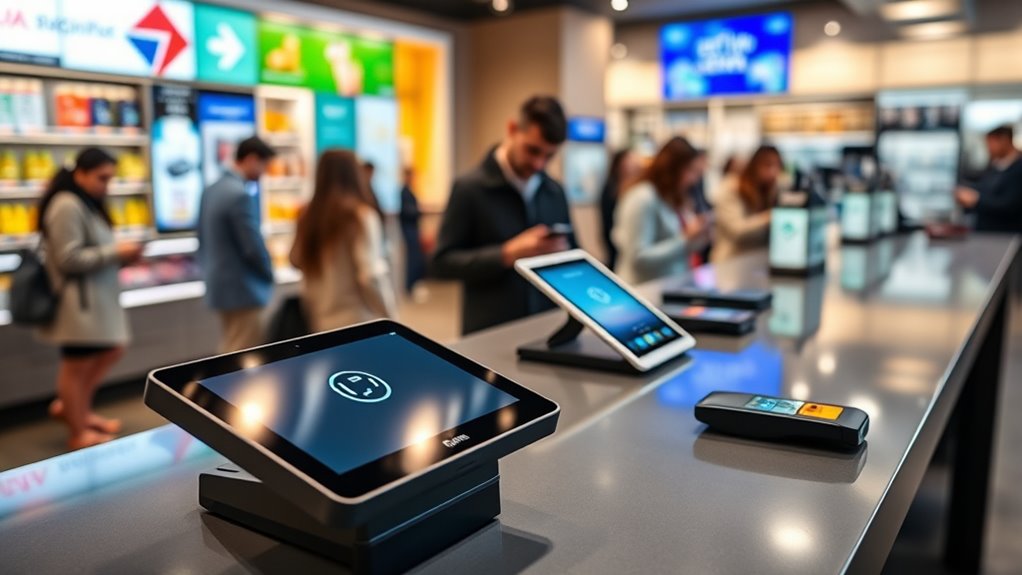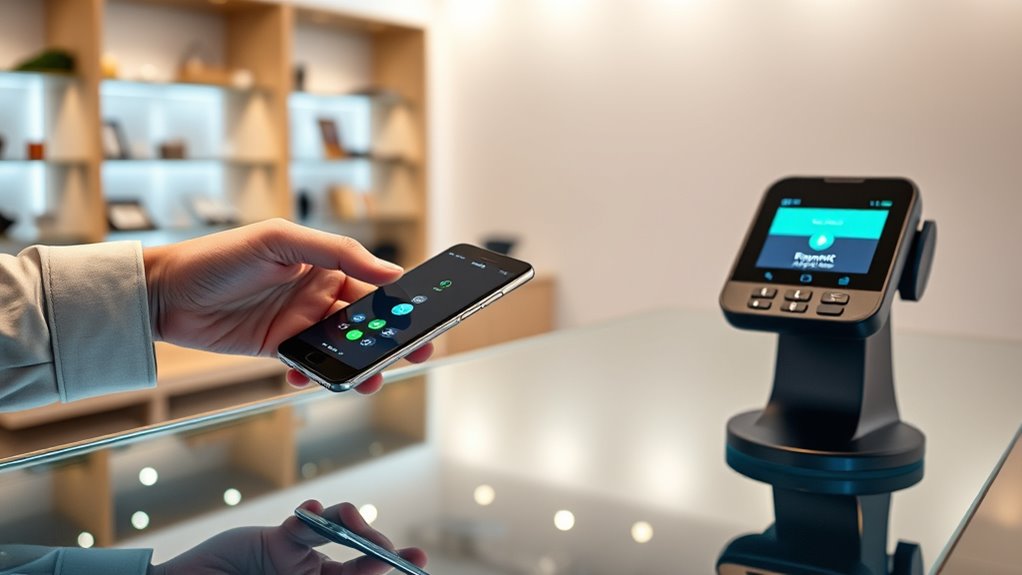To equip your business for cashless payments, start by adopting digital payment methods like contactless cards and mobile wallets such as Apple Pay or PayPal. Incorporate user-friendly, mobile-friendly payment solutions to meet customer preferences and stay competitive. Expand your payment options to include credit and debit cards, ensuring accessibility for all. Staying updated on emerging payment trends allows you to seize new opportunities and future-proof your business—continue on to discover practical steps to succeed.
Key Takeaways
- Implement multiple digital payment options like contactless cards, mobile wallets, and QR code payments to cater to diverse customer preferences.
- Invest in POS systems compatible with emerging payment technologies to ensure seamless, secure transactions.
- Prioritize mobile-friendly checkout experiences, including mobile wallets and tap-to-pay solutions.
- Educate staff on digital payment methods and security protocols to enhance customer confidence and service.
- Regularly monitor industry trends and update your payment infrastructure to stay competitive in the growing cashless economy.

Have you noticed how cashless payments are transforming the way we shop and pay? More than half of Americans used no cash in a typical week by 2025, a dramatic increase from just 11% in 2022. This shift reflects a broader trend, with over 13% of Americans reporting they don’t use cash at all in 2024. If you’re running a business, embracing this change means adapting your payment options to meet customer expectations. Younger consumers, especially those aged 18-24, rely heavily on mobile phones for nearly half of their transactions, highlighting the importance of mobile-friendly payment methods. Meanwhile, households earning less than $25,000 tend to depend more on cash, but even they are increasingly exposed to digital payments.
Cashless payments are reshaping shopping habits, especially among younger consumers relying on mobile devices.
The prevalence of cashless transactions continues to grow rapidly. In 2024, about 87% of all transactions in the U.S. were cashless, and projections suggest this could reach over 94% by 2027. Globally, the trend is similar, with 85% of point-of-sale transactions cashless in 2024, up from 74% in 2018. The contactless payments market alone is expected to hit nearly $91 billion by 2023, with transaction values worldwide surpassing $10 trillion by 2027. This growth is driven by the adoption of digital wallets and contactless card payments, which are becoming the standard for many consumers. Over 5.2 billion digital wallet users are expected worldwide by 2026, emphasizing the importance of integrating these options into your business. Recognizing this shift can help you stay competitive in today’s digital economy.
When considering payment methods, credit and debit cards dominate the scene, with over 81% of U.S. shoppers preferring card payments over cash. Consumers are twice as likely to use credit cards for transactions, especially in higher-income brackets earning over $150,000 annually, where credit card usage accounts for roughly half of all payments. Mobile wallets, like Apple Pay, are also gaining ground, with Apple Pay accounting for the majority of mobile wallet transactions in 2021. PayPal remains the top online payment processor, with nearly all of its users owning smartphones, making mobile compatibility essential. In fact, mobile payments are expected to account for nearly 50% of all transactions by 2025, underscoring the need for businesses to prioritize mobile-friendly payment solutions. Staying updated on digital payment trends can help you leverage new opportunities and meet customer demands effectively.
Frequently Asked Questions
What Are the Security Risks Associated With Cashless Payments?
You need to be aware of the security risks with cashless payments. Cybercriminals target your payment systems with fraud, hacking, and malware. Phishing scams can steal sensitive info, and contactless tech can be intercepted. System outages, data breaches, and financial crimes also threaten your business. To stay protected, use advanced security measures like encryption, multi-factor authentication, and backup systems to prevent and respond to these threats effectively.
How Do Businesses Handle Refunds in a Cashless System?
Think of handling refunds like steering through a maze—you need clear signs and a reliable map. When you process refunds in a cashless system, you verify the original purchase with receipts or transaction data, ensuring legitimacy. You initiate refunds through POS or online gateways, and keep customers updated with real-time status alerts. This smooth process builds trust, prevents fraud, and guarantees your business stays on the right path.
What Is the Cost of Adopting Cashless Payment Technology?
When you adopt cashless payment technology, expect initial costs like developing custom apps costing $40,000 to over $200,000, and POS hardware upgrades up to $2,500 per register. You’ll also face ongoing expenses like maintenance ($1,000 annually per register), transaction fees, and infrastructure costs such as WiFi (£10,000 for large events). Balancing these costs against long-term savings and improved efficiency determines your overall investment and return on investment.
How Do Cashless Payments Impact Customer Privacy?
Think of cashless payments as a clear window into your customers’ lives. You might enjoy the convenience, but it also means their spending habits, personal data, and even health info become visible to companies and governments. This erodes their privacy and can lead to targeted advertising or surveillance. As a business, you need to balance tech benefits with respecting customer privacy, ensuring they feel safe and trusted.
What Are the Best Practices for Training Staff on New Payment Systems?
You should develop a tailored training plan that combines theoretical knowledge with hands-on practice. Break sessions into modules to fit staff schedules, and include simulations of real transactions and troubleshooting scenarios. Teach security protocols and customer communication skills. Regular refresher courses keep everyone updated on system upgrades. Encourage collaborative learning and self-paced resources, ensuring staff gain confidence and efficiency with the new payment system, ultimately enhancing customer experience and operational flow.
Conclusion
Embracing cashless payments isn’t just a trend; it’s the doorway to a seamless, modern future for your business. Imagine your storefront as a vibrant hub, where transactions flow effortlessly like a well-conducted symphony. By equipping yourself with the right tools, you’re not just keeping up—you’re setting the stage for growth and innovation. So, step boldly into this new world, and watch your business flourish in the glow of digital possibility.









